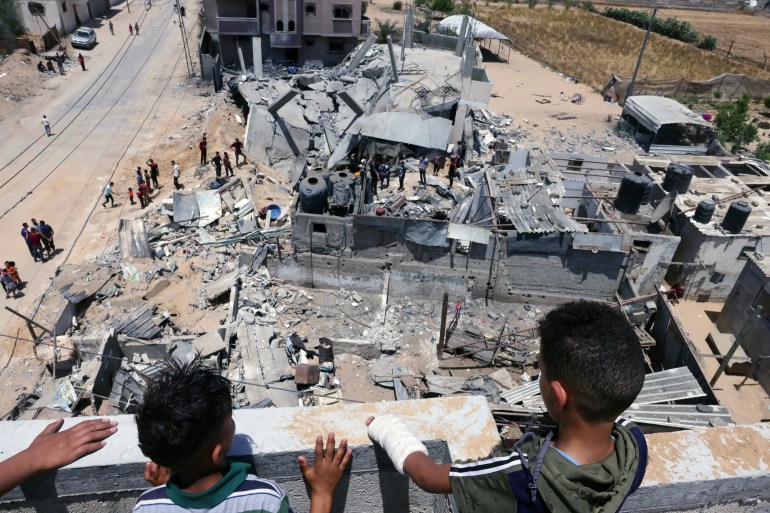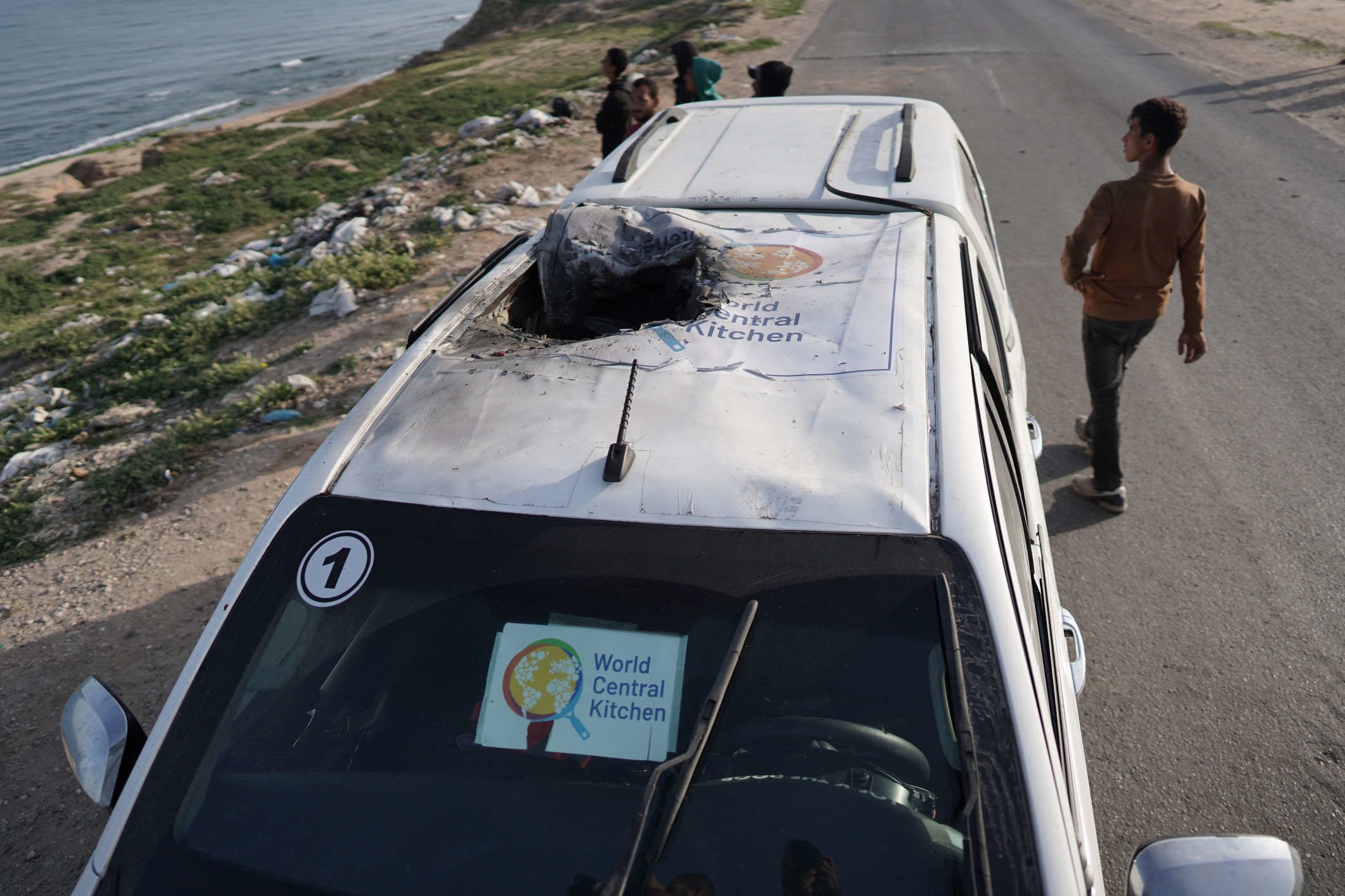
Over 350 Humanitarian Sites and
Convoys Have Been Attacked in Gaza
Connor Freeman/ Libertarian Institute
(April 16, 2024) — Prior to the Israeli military’s slaughter of seven World Central Kitchen (WCK) aid workers in Gaza this month, Middle East Eye (MEE) reports that at least 357 humanitarian-run sites and convoys had been attacked.
As with the incident involving the slain WCK workers, which included an American citizen, the humanitarian orgs shared their coordinates in advance of operations with the warring parties
. Israel hit them anyway and UN officials have warned of great difficulty in repairing the broken humanitarian notification system.
Current data shows that at least 216 aid workers have been killed during Israel’s indiscriminate bombing and relentless war on the Palestinian people trapped in the besieged, highly dense, coastal enclave. Aid workers told Middle East Eye the “scale of the incidents was unprecedented, even compared to the most dangerous war zones and emergencies they have experienced.” The vast majority of aid workers slaughtered have been employed by UNRWA, the UN aid agency for Palestinian refugees.
Nearly 34,000 people have been confirmed killed so far amidst Israel’s genocidal campaign, including more than 20,000 women and children. Brice de la Vingne, the head of the Doctors Without Borders (MSF) emergency unit said “To be frank, every single day we are discussing internally whether to leave Gaza. We should not be there.” He added, “The level of risk we are taking, I’ve never seen.”
He explained that aid operations in other wars are conducted outside the areas of actual fighting but the entire Strip has become a war zone. “In Gaza, we are in this nightmarish hell scenario where we are working in an environment where people are not supposed to be,” Vingne lamented.

According to the report, “The majority of the hits to deconfliction humanitarian sites – 352 – were to locations run by UNRWA, the largest aid organization operating in Gaza, including a food distribution center and schools sheltering thousands of civilians.”
MEE also found there were at least five other occasions where humanitarian sites or convoys were attacked including “a compound in Al-Mawasi housing staff working for the International Rescue Committee and Medical Aid for Palestine, the Gaza City offices ofDoctors of the World, a [MSF] convoy in Gaza City and an MSF shelter in Al-Mawasi, and an American Near East Refugee (ANERA) shelter in Deir al-Balah.”
Despite Israeli Defense Minister Yoav Gallant’s announcement of a new deconfliction cell for humanitarian aid groups, Jamie McGoldrick, the outgoing top UN aid official in Gaza, told the outlet “nothing substantive” has changed. Two weeks after the high-profile massacre of the WCK employees, communication between aid workers and the Israeli military regarding their location remains broken down or non-existent.
McGoldrick, whose final day at the post was last Friday, maintains that aid workers in the Gaza Strip require not only a hotline to correspond directly with the IDF but also must be provided with satellite phones and two-way radios. In other conflict zones, this is standard operating procedure. Not so amid Israel’s onslaught in the Strip, however, these devices are not furnished to aid workers ostensibly because the IDF fears they will fall into the hands of Hamas.
As Israel uses starvation as a weapon of war, the entire population in Gaza is on the brink of famine. Officials from the State Departmentand USAID have admitted that famine is already taking place in the northern parts of the Strip, where McGoldrick has warned that despite Israeli assurances the aid distribution system has seen no improvement.
The broken deconfliction system for aid workers in the Strip will only spell more deaths of deprivation, experts estimate that the death toll will surpass 100,000 by August if the situation remains unchanged. Moreover, Gaza’s medical system and infrastructure has been decimated by the Israeli campaign. Last month, the World Health Organization released statistics exposing that in excess of 400 medical facilities have been hit, killing nearly 700 people.

The Israeli air, land, and sea blockade imposed on the illegally occupied enclave 17 years ago was severely tightened after the October 7th Hamas attack on southern Israel. Gallant announced days later that the “human animals” living in the Strip, which includes more than a million children, will be indefinitely cut off from food, water, fuel, and medicine.
After the WCK massacre, the group ended its operations in Gaza along with ANERA. WCK had been providing more hot meals in Gaza than UNRWA and the World Food Program combined. In January, Israel launched a propaganda war against UNWRA by accusing some of their employees of having ties to Hamas and the October 7th attack.
More than a dozen Western countries including the United States stripped funding for the vital agency, over Tel Aviv’s claims which were supported by no evidence. UNRWA has since revealed that its aid workers were subjected to rape and waterboarding at the hands of the IDF seeking to extract just such spurious confessions.
During previous Israeli wars against Lebanon and Gaza, there was significant communication between the UN and COGAT, the Israeli agency overseeing the occupied territories, as well as its ancillary the Civilian Liaison Administration which is focused on the Strip. This is now not taking place.
If aid workers experience a security risk or incident, when they are in enroute to a destination or attempting to pass through a checkpoint, it is not possible to communicate with the IDF.
McGoldrick explained to MEE, the UN “should have pushed harder earlier in the conflict to get closer to the Israeli military, if not physically embedding someone in a joint operations room, then at least being able to have a face-to-face conversation online, in real time.” This is imperative for two reasons, he said, “First, they understand better what you do and how you do it. Secondly, you can build trust in terms of what your expectations are on both sides.”

According to Grisha Yakubovich, the former chief of COGAT until 2016, previous Israeli bombing sprees against the open-air concentration camp saw UN and COGAT officials meet on a virtually daily basis to share plans for the next 24 hours. Yakubovich told the Washington Post this is not the case anymore because Israel’s military practically refuses to work with the UN. The IDF cites their lies about UN employees’ alleged ties with Hamas to justify the ongoing humanitarian catastrophe the Israeli war has wrought.
Other aid agencies besides the UN have expressed great frustration over the lack of a clear response, if any, when their sites are bombed by Israeli pilots. For instance, the International Rescue Committee and Medical Aid for Palestine says the Israeli authorities gave six different explanations for why an F-16 jet targeted one of their stand-alone compounds with a 1,000 pound “smart bomb” in January, weeks after their coordinates had been shared.
“It is clear from this experience that the Israeli military and government are either unable or unwilling to properly investigate this serious incident,” the group stated.
Posted in accordance with Title 17, Section 107, US Code, for noncommercial, educational purposes.